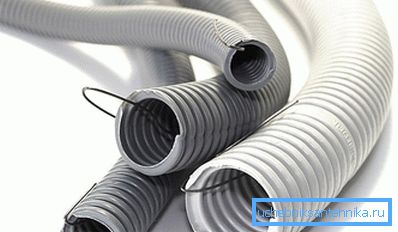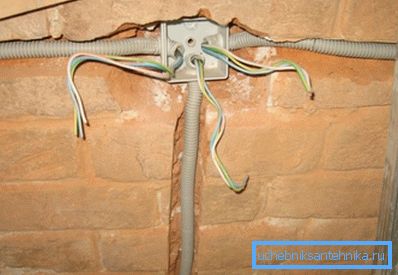Pvc plastic corrugated pipe for electrical work
When performing external or internal laying of low-current and power cable networks, for safe and uninterrupted operation it is important to ensure reliable protection of the supply cable from moisture and external mechanical damage.
In this case, the most suitable means of protection is a flexible corrugated pipe made of rigid polyvinyl chloride, the use of which helps to solve several issues at once.

The use of corrugated pipes in individual construction
In order to have an idea of the proper performance of electrical installation, this article will discuss the main aspects of using plastic corrugated pipe when laying home cable lines.
Also, a step-by-step instruction will be presented here that describes the technology of laying the cable in a protective corrugated sleeve using a wire probe.

Specifications
It should be noted right away that this type of product was designed specifically for laying electrical networks, therefore the physical properties and basic technical characteristics of PVC corrugated pipe fully comply with all building codes and fire safety regulations.
- Hard PVC is absolutely not affected by moisture and most corrosive environments, resistant to UV rays, does not age with time and does not degrade under the influence of ozone, therefore, it can be used for both internal and external works.
- The operating temperature range of operation is in the range of -20 ° C to +80 ° C.
- PVC is a self-extinguishing material., which does not support independent burning, therefore it can be used for the installation of electrical wiring, both in wooden and in brick buildings.
- The minimum insulation resistance at a voltage of 500 V is 100 mΩ, and the dielectric strength index is at least 2 kV, that allows you to use it in electrical installations with a voltage of up to 1000 V.
- Depending on the type of pipe, the nominal resistance to compression is: for a light series 320 N / 5 cm, for a heavy series - 750 N / 5 cm, and for a super heavy one - 1250 N / 5 cm.

Note! The corrugated pipe is delivered to the retail sale rolled up in coils from 50 to 200 m long, and its price mainly depends on the outer diameter. The color most often is light gray (RAL 7035), but there are also other (black, orange) colors.
Diameter selection
In individual housing construction plastic corrugated sleeves with outer diameter from 16 to 63 mm are most often used. The choice of the desired diameter should be made in accordance with the above table 1, depending on the number and cross-sectional area of the wires used.
Table 1.
| The cross-sectional area of the wire, mm ?. | Number of wires, pcs. | External diameter of the pipe, mm. |
| 1.5 | 2/3/4/5 | 16/16/20/20 |
| 2.5 | 2/3/4/5 | 16/16/20/25 |
| four | 2/3/4/5 | 20/20/25/25 |
| 6 | 2/3/4/5 | 20/25/32/32 |
| ten | 2/3/4/5 | 25/32/32/40 |
| sixteen | 2/3/4/5 | 32/32/40/40 |
| 25 | 2/3/4/5 | 32/40/50/50 |
| 35 | 2/3/4/5 | 40/50/50/63 |
| 50 | 2/3/4/5 | 50/50/63/63 |
| 70 | 2/3/4 | 50/63/63 |
| 95 | 2/3 | 63/63 |
| 120 | 2 | 63 |
| 150 | 2 | 63 |
Note! In accordance with the data in the table, it can be concluded that the physical characteristics of a 16 mm corrugated PVC pipe make it possible to use it for laying two or three wire wires with a cross section of 1.5 to 2.5 mm ?.

Application area
Based on the practice of using corrugated sleeves in individual construction, when performing electrical work with your own hands, for the optimal choice of the outer diameter, you should follow the following rules.
- Installation in pipes of electrical installation of wall and ceiling lamps - D = 16 mm.
- Connecting light switches and consumer sockets - D = 20 mm.
- Cable laying in plastic pipes between the electrical panel and distribution boxes - D = 25 m.
- The connection of the main electrical panel with the switchboard - D = 32 mm.
- For penetration of ceiling and interfloor ceilings, depending on the number of wires, a pipe diameter of 40 to 63 mm is selected.
- For laying coaxial, fiber optic and telephone cable networks can be used corrugated sleeve with a diameter of 16 to 25 mm.

Laying technology
Most often, a plastic corrugated sleeve is produced with a probe, that is, with a thin elastic metal wire, which is located in its inner lumen along the entire length.
The presence of the probe significantly speeds up the electrical work and simplifies the tightening of the cable in a flexible corrugated pipe.
- Before tightening the cable, measure the necessary amount of the corrugated sleeve, and carefully cut it off without cutting the probe wire.
- In the place of the cut to dissolve the ends of the corrugations in different directions, and cut the wire with wire cutters, bending its ends outside the edges of the pipe, preventing it from falling inside.
- Tie an electrical cable to one end of the probe, straighten the sleeve, and with a smooth movement over the wire, tighten the wire to its full length into a corrugated tube.
- Fix the ends of the wire using knots or plastic clamps outside the corrugated sleeve, preventing them from falling through the inner lumen.
- Lay the plastic pipe with the cable tightened into it into the pre-cut out chaser, or fix it to the wall with the help of special plastic holders.

Conclusion
After reading this article, it becomes clear that the use of flexible plastic corrugated pipe is a universal method for laying cable communications in the construction of buildings from any materials. For more information, you can watch the video in this article or read similar materials on our website.